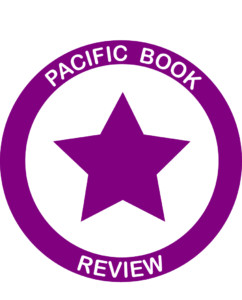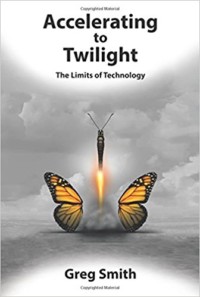Title: Accelerating to Twilight – The Limits of Technology
Author: Greg Smith
Publisher: Xlibris
ISBN: 978-1543426335
Pages: 270
Genre: Non-fiction
Reviewed by: Barbara Bamberger Scott
Pacific Book Review Star
Awarded to Books of Excellent Merit

Accelerating to Twilight provides an advisory for all of us about the impending changes we need to make to not only survive but to thrive on our planet.
Greg Smith, who has traveled extensively, uses the model of our earthly progress compressed into a single day. In the dawn of known time, humans lived nomadically in the wild and foraged for subsistence. Gradually such innovations as shelters and agriculture changed the pattern, and with settlement came the invention of tools and housewares and the evolution of art and religion. By the end of the nineteenth century we had such amazing new devices as telescopes, telegraphs, eyeglasses, internal combustion engines, chemical fertilizers, and sophisticated weapons of war.
The twentieth/early twenty-first centuries brought an incredible range of advances, in warfare, food production, transportation and most noticeably in telephony communications – evolving from the “candlestick” telephone to the cell phone all in about 50 years. The author refers to this period as the “rush hour” of technological development. He points out the biggest losers in this rush are ordinary workers; as the technology involved in production and distribution directly affects employment since the cheaper the service for the consumer, the lower the pay of those few required to create it.
Now we are heading towards twilight of our long day and perceiving disturbing limits. Air travel is actually at times slower because of ground congestion taking longer to get to the airport. Drones and other weapons have made warfare faster, far more deadly, while at the same time more impersonal. In the realm of communication, how much faster can it possibly get than nearly instantaneous? Agriculture concentrates on the development of a few synthetic crops to the detriment of natural foods and small-scale farming. The invention of the birth control pill, combined with the eerie concept of genetic engineering, points towards even more incursion of science into the personal sphere. Our wants have become virtually limitless; we believe we need every new hi-tech device. All the while, wealth is in the hands of the few, feverishly inventing, improving and marketing technology for the masses, who grow poorer yet still long to be placated by the latest microchip miracle.
The author urges us to remember the place of God, though not here advocating for any specific religious approach, in these rapidly changing times. Faith, in his model, is ever more important as we head for nightfall. He suggests constructing a future that is Life Centered. He admits a total rejection of the two-dimensional world of computerized devices may not be possible, but it is possible to involve ourselves more in the three-dimensional real world, slowing down our pace by walking or bicycling, for example and recommitting to smaller, simpler solutions to our problems. “The challenge,” the author believes, “becomes changing the conversation away from the sensational gloom and steely reality of technology as the dominant force on earth.”
Smith’s book is based on credible research, as he states his case logically. While he posits his ideas, we find little room for optimism about the consequences if we do not make some significant alterations in our personal and communal lives. His picture of a Life Centered world is alluring and could, perhaps should, invoke a social movement. Accelerating to Twilight – The Limits of Technology is a fascinating read for many fans of technology, futurist social economics and people seeking balance and harmony within their lives; as the pace of our development needs to have the objective reflection of where we have been in order to help guide us to where we are going.



Follow Us